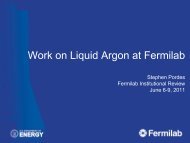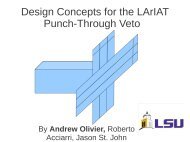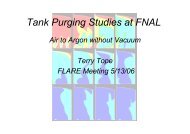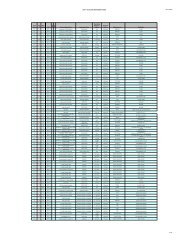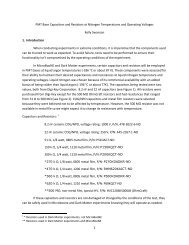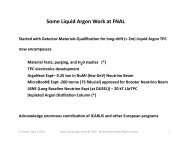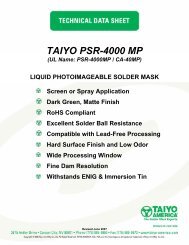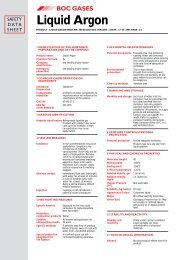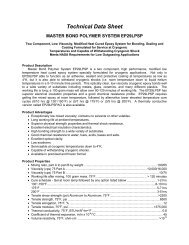Purification of Liquid Krypton for GEM - LArTPC DocDB
Purification of Liquid Krypton for GEM - LArTPC DocDB
Purification of Liquid Krypton for GEM - LArTPC DocDB
You also want an ePaper? Increase the reach of your titles
YUMPU automatically turns print PDFs into web optimized ePapers that Google loves.
<strong>GEM</strong> TN-93-298<br />
ge<br />
<strong>Purification</strong> <strong>of</strong> <strong>Liquid</strong> <strong>Krypton</strong> <strong>for</strong> <strong>GEM</strong><br />
David C. Rahm<br />
Brookhaven National Laboratory<br />
February 9, 1993<br />
Abstract:<br />
Following tests at Brookhaven and at CERN, it became clear that special<br />
precautions and purification will be necessary to use Kr in a calorimeter as<br />
compared to using Ar. My conclusions are that <strong>GEM</strong> must be very careful in the<br />
choice <strong>of</strong> construction materials and provide <strong>for</strong> purification <strong>of</strong> the Kr in both<br />
the liquid and gas phases.
1<br />
9 February 1993<br />
PURIFICATION OF LIQUID KRYPTON FOR <strong>GEM</strong><br />
David C. Rahm<br />
Physics Department<br />
BROOKHAVEN NATIONAL LABORATORY<br />
ABSTRACT<br />
Following tests at Brookhaven and at CERN, it became clear that spe<br />
cial precautions and purification will be necessary to use Kr in a calorimeter<br />
as compared to using Ar. My conclusions are that <strong>GEM</strong> must be very care<br />
ful in the choice <strong>of</strong> construction materials and provide <strong>for</strong> purification <strong>of</strong><br />
the Kr in both the liquid and gas phases.<br />
Experimental Observations<br />
In the summer <strong>of</strong> 1992 a test run with a liquid <strong>Krypton</strong> accordion style calorimeter was<br />
per<strong>for</strong>med at Brookhaven National Laboratory.<br />
1-2 The <strong>Krypton</strong> came from Novosibirsk<br />
in the framework <strong>of</strong> the <strong>GEM</strong> collaboration. The Kr was tested by Pr<strong>of</strong>. Elena Aprile<br />
<strong>of</strong> Columbia University and found to be as good as any other commercial Kr that she<br />
had used. Her calorimeter was a very clean calorimeter using only materials that could be<br />
pumped down to a good vacuum. In contrast our calorimeter used Rohacell foam inside the<br />
cryostat as insulation and as excluder <strong>of</strong> liquid between the calorimeter and the cryostat<br />
wall where the beam would pass. CERN experiments NA-31 and NA-34 used Rohacell in<br />
liquid Argon calorimeters, with no negative effect on the per<strong>for</strong>mance <strong>of</strong> the calorimeter.<br />
The experience from NA-34 showed that the foam holds considerable water, which was<br />
partially removed by pumping, but the residual gas, even after several days <strong>of</strong> pumping,<br />
was still water. Pr<strong>of</strong>. Aprile did a test in Kr with a piece <strong>of</strong> Rohacell in the cryostat, and<br />
found that it was not possible to achieve as good a vacuuum and that there was a marked<br />
decrease in the electron signal.<br />
Our test used accordion plates fabricated using the CERN RD3 equipment. First we<br />
ran with liquid Ar <strong>for</strong> several weeks and had very good signals. The Ar was emptied and<br />
the cryostat pumped be<strong>for</strong>e the Kr was introduced. The signals from our test cell in the
2<br />
liquid Kr, using the ionization signal from alpha particles, showed a large reduction in the<br />
signal. As Kr was added the signal got better until the filling was stopped. Then the signal<br />
started to fall until we put our purifier into service.<br />
The purifier used Oxisorb from MG Industries Messer Greisheim in Germany, fol<br />
lowed by a getter purifier from SAES Pure Gas, which is claimed to remove essentially all<br />
impurities from a noble gas. With a flow rate <strong>of</strong> about 20 liters <strong>of</strong> gas per minute we were<br />
able to continuously increase the test cell signal, when the gas sample was drawn from<br />
liquid at the bottom <strong>of</strong> the cryostat. When we switched to drawing the gas from the gas<br />
phase in the cryostat, the improvement in the signal stopped and the signal started de<br />
creasing. This behavior demonstrated that our impurities were concentrated in the liquid<br />
phase. This conclusion was further rein<strong>for</strong>ced by the increased rate <strong>of</strong> loss <strong>of</strong> signal as the<br />
calorimeter was emptied by removing gas from the top <strong>of</strong> the cryostat.<br />
One supplementary test during the period when we were purifying from the liquid<br />
phase was to bypass the getter purifier, so that only the Oxisorber was used. The rate <strong>of</strong><br />
increase <strong>of</strong> the test signal was unchanged, so it seems that the Oxisorber alone was capable<br />
<strong>of</strong> removing our set <strong>of</strong> impurities.<br />
Previous experience with additives in liquid Ar using a test cell with an alpha particle<br />
source showed no significant loss <strong>of</strong> the electrons as they drifted in a high field and across<br />
a small gap 10kv/cm and 2mm gap. Essentially all the loss was due to recombination<br />
at the origin <strong>of</strong> the ionization. In our Kr tests there was signal loss seen due to both loss<br />
at the origin and loss during the drift. The same impurities that caused us no trouble at<br />
90°K, were very bad at 123°K.<br />
After the test run at Brookhaven I went to CERN to work with the RD-3 collaboration<br />
on a test <strong>of</strong> the new 2m long accordion electromagnetic liquid Ar prototype. While at<br />
CERN I was able to have a number <strong>of</strong> very fruitful discussions. I described our results<br />
to D. Schinzel and G. Kesseler <strong>of</strong> the NA-48 experiment which had a prototype liquid Kr<br />
calorimeter. Their experience was different than ours at Brookhaven. With a comparable<br />
flow rate <strong>of</strong> purification, they were unable to stop a continual loss <strong>of</strong> signal. Tests with gas<br />
samples showed that the impurities were as much in the gas phase, as in the liquid phase.<br />
They had verified previously that none <strong>of</strong> the construction materials in the calorimeter were<br />
responsible <strong>for</strong> the signal loss. In the next test they changed their electrical feedthroughs
3<br />
which they suspected to be leaking, and found that even without purification, the signal was<br />
high and stable over 2 weeks <strong>of</strong> running. It thus appears that their previous contaminant<br />
was probably oxygen from leaks.<br />
There were presentations at CERN on gas purification by the firms SAES Getters and<br />
by Messer Greisheim. New getters are under development which should make <strong>for</strong> somewhat<br />
simplified systems in the future. SAES appears to be the world leader in getters, their<br />
materials being used <strong>for</strong> high vacuum pumping in LEP at CERN and in the transfer line<br />
<strong>for</strong> the low energy heavy ion beam at Brookhaven. When I investigated buying a purifier,<br />
I was told by a <strong>for</strong>mer competitor that the SAES system was the only product on the<br />
market that would remove essentially all inpurities from a noble gas.<br />
The large Oxisorb cartridge, from MG Ind., that we used has two different materi<br />
als inside. The Oxisorb material is chromic tn-oxide which interacts with oxygen, with<br />
branched chain hydrocarbons, and with a number <strong>of</strong> other chemicals. The other compo<br />
nent is molecular sieve 5A which is very good <strong>for</strong> water removal. While at the presentation<br />
by Messer Greisheim, someone from the Icarus project reported on the use <strong>of</strong> a special<br />
Oxisorb cartridge, the body <strong>of</strong> which they made and that Messer Greisheim filled. The<br />
cartridge is about 10 cm i.d. and about 80 cm long. They filled their test vessel with<br />
liquid Ar passing through the cartridge, at a rate <strong>of</strong> about 1/2 m3 per hour <strong>of</strong> liquid. This<br />
is a very high rate compared to gaseous purifiers. They found that their. drift lifetime was<br />
very long, corresponding to an equivalent oxygen contamination <strong>of</strong> much less than 1 ppb.<br />
Oxisorb will work down to liquid nitrogen temperatures.<br />
Recommendations<br />
I would recommend that the calorimeters <strong>for</strong> <strong>GEM</strong> should have provisions <strong>for</strong> purifying<br />
both in the liquid and gas phases. The cryostats should have provisions <strong>for</strong> withdrawing<br />
liquid from the bottom and returning it to the top. This will require a cryogenic pump to<br />
overcome the resistance in the Oxisorb liquid phase cartridges resistance mainly due to<br />
the particulate filter in the input and output lines. In addition there should be provision<br />
<strong>for</strong> purification in the gas phase by withdrawing liquid from the bottom, gasifying it and<br />
returning it to the top <strong>of</strong> the cryostats. It would also be prudent to have the capability <strong>of</strong><br />
purifying the liquid in the storage dewars, and or, when filling or emptying them.
4<br />
It now seems clear that Rohacell should not be used in liquid Kr. Some other method<br />
<strong>of</strong> excluding liquid must be used. The testing by NA-48 showed no problems with normal<br />
printed circuit boards, Kapton, or with poly-vinyl-chloride insulated wires. It would be<br />
worth while testing other types <strong>of</strong> foams.<br />
Acknowledgments<br />
I wish to thank Pr<strong>of</strong>. E. Aprile <strong>for</strong> her tests with our Kr and with Rohacell in Kr. D.<br />
Fournier and other members <strong>of</strong> the RD3 collaboration have been always helpful. Special<br />
thanks go to G. Kesseler and D. Schinzel who communicated to me the results <strong>of</strong> their<br />
tests <strong>for</strong> the NA-48 experiment, and to P. Picchi and S. Suzuki <strong>of</strong> the Icarus project.<br />
References<br />
1. B. Aubert et al. RD3 Collaboration,Nucl. Instr. and Meth. A309, 199 1991.<br />
2. D. Lissauer, 26th Intl. Conf. on High Energy Physics, 6-12 Aug, 1992 Dallas, TX..<br />
3. D. Rahm,Nucl. Instr. and Meth. A316, 67 1992.





